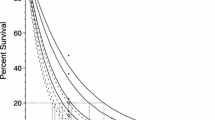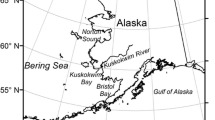Abstract
European Atlantic salmon (Salmo salar) populations inhabit rivers from northern Portugal to northern Norway across a wide spectrum of environmental variability. To address whether single physical factors might lead to genetic divergence of isolated populations, we compared the digestive performances total digestibility, relative nitrogen digestibility, passage time, and digestion rate (g dry matter · h−1) — of northern (Scotland) and southern (Asturias, northern Spain) populations at three temperature regimes (5, 12, and 20° C). Total dry matter digestibilities increased directly with temperature but were similar for both populations at each of the three trials. Relative nitrogen digestibility did not differ between populations nor among temperature regimes. In contrast, passage time was significantly longer for low-than for high-latitude fish at both 5 and 20° C. When the percentage of food digested and the passage time were integrated as digestion rates (food digested per unit time), a significant population × temperature interaction consistent with a genotype × environment interaction was detected in addition to the population and temperature effects. This implies that not only is the digestive performance of the high-latitude population higher throughout the range of temperatures examined, but moreover the difference is reinforced at high temperatures, where the digestion rate of high-latitude fish was 1.6 times greater. Taken together, these two results provide preliminary evidence for countergradient variation in digestive rates of salmonids in response to variation in growth opportunity. The data support our previous work on the same two populations showing differences in growth rates, and underlie one of the possible mechnisms leading to more rapid growth of the high-latitude fish when both populations are reared in a common environment.
Similar content being viewed by others
References
Allendorf FW, Phelps SR (1981) Use of allelic frequencies to describe population structure. Can J Fish Aquat Sci 38: 1507–1514
Allendorf FW, Knudsen KL, Leary RF (1983) Adaptive significance of differences in the tissue-specific expression of a phosphog-lucomutase gene in rainbow trout. Proc Natl Acad Sci USA 80: 1397–1400
Beacham TD (1988) A genetic analysis of early development in pink (Oncorhynchus gorbuscha) and chum salmon (Oncorhynchus keta) at three different temperatures. Genome 30: 89–96
Beacham TD, Murray CB (1988) Influence of photoperiod and temperature on timing of sexual maturity of pink salmon (Oncorhynchus gorbuscha). Can J Zool 66: 1729–1732
Berven KA, Gill DE (1983) Interpreting geographic variation in life-history traits. Am Zool 23: 85–97
Berven KA, Gill DE, Smith-Gill SJ (1979) Countergradient selection in the green frog,Rana clamitans. Evolution 33: 609–623
Bird DF, Prairie YT (1985) Practical guidelines for the use of zooplankton length-weight regression equations. J Plankt Res 7: 955–960
Bjordal KA (1989) Flexibility of digestive responses in two generalist herbivores, the tortoisesGeochelone carbonaria andGeochelone denticulata. Oecologia 78: 317–321
Bjorndal KA (1991) Diet mixing: nonadditive interactions of diet items in an omnivorous freshwater turtle. Ecology 72: 1234–1241
Blaxter JHS (1992) The effect of temperature on larval fishes. Netherl J Zool 42: 336–357
Booth DJ (1990) Effect of water temperature on stomach evacuation rates, and estimation of daily food intake of bluegill sunfish (Lepomis macrochirus Rafinesque). Can J Zool 68: 591–595
Brett JR, Higgs DA (1970) Effect of temperature on the rate of gastric digestion in fingerling sockeye salmon,Oncorhynchus nerka. J Fish Res Bd Can 27: 1767–1779
Clarke MRB (1980) The reduced major axis of a bivariate sample. Biometrika 67: 441–446
Conover DO (1992) Seasonality and the scheduling of life history at different latitudes. J Fish Biol 41 B: 161–178
Conover DO, Present TMC (1990) Countergradient variation in growth rate: compensation for length of the growing season among Atlantic silversides from different latitudes. Oecologia 83: 316–324
Cossins AR, Bowler K (1987) Temperature biology of animals. Chapman and Hall, London
Cunjak RA (1988) Physiological consequences of overwintering in streams: the cost of acclimitization? Can J Fish Aquat Sci 45: 443–452
Cunjak RA, Curry RA, Power G (1987) Seasonal energy budget of brook trout in streams: implications of a possible deficit in early winter. Trans Am Fish Soc 116: 817–828
Dehnel PH (1955) Rates of growth of gastropods as a function of latitude. Physiol Zool 28: 115–144
Elliott JM (1972) Rates of gastric evacuation in brown trout,Salmo trutta L. Freshwater Biol 2: 1–18
Elliott JM (1991) Tolerance and resistance to thermal stress in juvenile Atlantic salmon,Salmo salar. Freshwater Biol 25: 61–70
Emlen JM (1966) The role of time and energy in food preference. Am Nat 100: 611–617
Fraser NHC, Metcalfe NB, Thorpe JE (1993) Temperature-dependent switch between diurnal and nocturnal foraging in salmon. Proc R Soc London B 252: 135–139
Godin J-GJ, Rangeley RW (1989) Living in the fast lane: effects of cost of locomotion on foraging behaviour in juvenile Atlantic salmon. Anim Behav 37: 943–954
Gotceitas V, Godin J-GJ (1991) Foraging under the risk of predation in juvenile Atlantic salmon (Salmo salar L.): effects of social status and hunger. Behav Ecol Sociobiol 29: 255–261
Grande M, Andersen S (1991) Critical thermal maxima for young salmonids. J Freshwater Ecol 6: 275–280
Hart PJB, Gill AB (1992) Constraints on prey size selection by the three-spined stickleback: energy requirements and the capacity of fullness of the gut. J Fish Biol 40: 205–218
Henderson PA, Holmes RHA, Bamber RN (1988) Size-selective overwintering mortality in the sand smelt,Atherina boyeri Risso, and its role in population regulation. J Fish Biol 33: 221–233
Higgins PJ, Talbot C (1985) Growth and feeding in juvenile Atlantic salmon (Salmo salar L.). In: Cowey CB, Mackie AM, Bell JG (eds) Nutrition and feeding in fish. Academic Press, London, pp 243–263
Hochachka PW, Somero GN (1971) Biochemical adaptation to the environment. In: Hoar WS, Randall DJ (eds) Fish physiology, vol VI. Academic Press, New York, pp 100–156
Jensen AJ, Johnsen BO (1986) Different adaptation strategies of Atlantic salmon (Salmo salar) populations to extreme climates with special reference to some cold Norwegian rivers. Can J Fish Aquat Sci 43: 980–984
Jensen AJ, Johnsen BO, Saksgård L (1989) Temperature requirements in Atlantic salmon (Salmo salar), brown trout (Salmo trutta), and arctic charr (Salvelinus apinus) from hatching to initial feeding compared with geographic distribution. Can J Fish Aquat Sci 46: 786–789
Jolicoeur P, Mosimann JE (1968) Intervalles de confiance pour la pente de l'axe majeur d'une distribution normale bidimensionelle. Biometrie-Praximetrie 9: 121–140
Jordan WC, Youngson AF, Webb JH (1990) Genetic variation at the malic enzyme-2 locus and age at maturity in sea-run Atlantic salmon (Salmo salar). Can J Fish Aquat Sci 47: 1672–1677
Kaufmann R, Wieser W (1992) Influence of temperature and ambient oxygen on the swimming energetics of cyprinid larvae and juveniles. Environ Biol Fish 33: 87–95
L'Abée-Lund JH, Jonsson B, Jensen AJ, Sættem LM, Heggberget TG, Johnsen BO, Næsje TF (1989) Latitudinal variation in life-history characteristics of sea-run migrant brown troutSalmo trutta. J Anim Ecol 58: 525–542
Levins R (1969) Thermal acclimation and heat resistance inDrosophila species. Am Nat 103: 483–499
Levinton JS (1983) The latitudinal compensation hypothesis: growth data and a model of latitudinal growth differentiation based upon energy budgets. I. Interspecific comparison of Ophryotrocha (Polychaeta: Dorvilleidae). Biol Bull 165: 686–698
Lonsdale DJ, Levinton JS (1985) Latitudinal differentiation in copepod growth: an adaptation to temperature. Ecology 66: 1397–1407
Marken Lichtenbelt WD van (1992) Digestion in an ectothermic herbivore, the green iguana (Iguana iguana): effect of food composition and body temperature. Physiol Zool 65: 649–673
McArdle BH (1988) The structural relationship: regression in biology. Can J Zool 66: 2329–2339
Metcalfe NB, Thorpe JE (1990) Determinants of geographical variation in the age of seaward migrating salmon,Salmo salar. J Anim Ecol 59: 135–145
Metcalfe NB, Thorpe JE (1992) Anorexia and defended energy levels in over-wintering juvenile salmon. J Anim Ecol 61: 175–181
Milton K (1981) Food choice and digestive strategies of two sympatric primate species. Am Nat 117: 496–505
Nicieza AG, Braña F (1993) Compensatory growth and optimum size in one-year old smolts of Atlantic salmon (Salmo salar). In: Gibson RJ, Cutting RE (eds) Production of juvenile Atlantic salmon,Salmo salar, in natural waters Can. Spec. Publ. Fish. Aquat. Sci. 118: 225–237
Nicieza AG, Reyes-Gavilán FG, Braña F (1994) Differentiation in juvenile growth and bimodality patterns between northern and southern populations of Atlantic salmon (Salmo salar L.). Can J Zool (72(8) in press)
Post JR, Evans DO (1989) Size-dependent overwinter mortality of young-of-the-year yellow perch (Perca flavescens): laboratory, in situ enclosure, and field experiments. Can J Fish Aquat Sci 46: 1958–1968
Potvin C, Lechowic LJ, Tardif S (1990) The statistical analysis of ecophysiological response curves obtained from experiments involving repeated measures. Ecology 71: 1389–1400
Rayner JMV (1985) Linear relations in biomechanics: the statistics of scaling functions. J Zool 206: 415–439
Rice WR (1989) Analyzing statistical tests. Evolution 43: 223–225
Rimmer DM, Saunders RL, Paim U (1985) Effects of temperature and season on the position holding performance of juvenile Atlantic salmon (Salmo salar). Can J Zool 63: 92–96
Sibly RM (1981) Strategies of digestion and defecation. In: Townsend CR, Calow P (eds) Physiological ecology: an evolutionary approach to resource use. Blackwell, Oxford, pp 109–139
Sprugel DG (1983) Correcting for bias in log-transformed allometric equations. Ecology 64: 209–210
Stearns SC, Koella JC (1986) The evolution of phenotypic plasticity in life-history traits: predictions of reaction norms for age and size at maturity. Evolution 40: 893–913
Taylor EB (1991) A review of local adaptation in Salmonidae, with particular reference to Pacific and Atlantic salmon. Aquaculture 98: 185–207
Thorpe JE (1988) Salmon migration. Sci Progr 72: 345–370
Thorpe JE (1989) Development variation in salmonid populations. J Fish Biol 35 A: 295–303
Torrissen KR (1991) Genetic variation in growth rate of Atlantic salmon with different trypsin-like isozyme patterns. Aquaculture 93: 299–312
Torrissen KR, Barnung TN (1991) Genetic difference in trypsin-like isozyme pattern between two strains of Artic charr (Salvelinus alpinus). Aquaculture 96: 227–231
Veloso C, Bozinovic F (1993) Dietary and digestive constraints on basal energy metabolism in a small herbivorous rodent. Ecology 74: 2003–2010
Verspoor E, Jordan WC (1989) Genetic variation at the Me-2 locus in the Atlantic salmon within and between rivers: evidence for its selective maintenance. J Fish Biol 35 A: 205–213
Wieser W (1991) Physiological energetics and ecophysiology. In: Winfield IJ, Nelson JS (eds) Cyprinid Fishes. Systematics, biology and exploitation. Chapman and Hall, London, pp 426–455
Windell JT (1978) Digestion and the daily ration of fishes. In: Gerking SD (ed) Ecology of freshwater fish production. Wiley, New York, pp 159–183
Wright S (1931) Evolution in Mendelian populations. Genetics 16: 97–159
Zimmerman LC, Tracy CR (1989) Interactions between the environment and ectothermy and herbivory in reptiles. Physiol Zool 62: 374–409
Author information
Authors and Affiliations
Rights and permissions
About this article
Cite this article
Nicieza, A.G., Reiriz, L. & Braña, F. Variation in digestive performance between geographically disjunct populations of Atlantic salmon: countergradient in passage time and digestion rate. Oecologia 99, 243–251 (1994). https://doi.org/10.1007/BF00627736
Received:
Accepted:
Issue Date:
DOI: https://doi.org/10.1007/BF00627736




